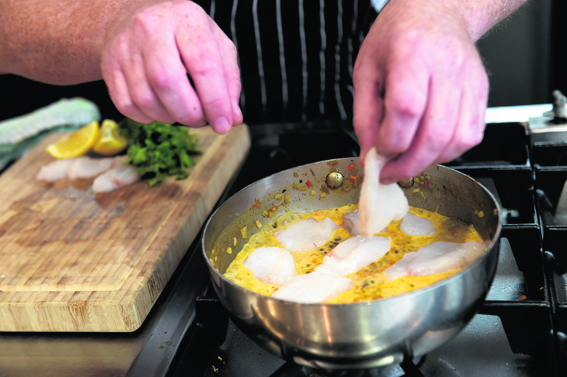The leaves are starting to fall and there may be a nip in the air – time to serve some wonderfully warming dishes made with Scottish produce and Asian flavours. Today’s coconut beef recipe brings together a real fusion of flavours while the dressing is sweet and sour, zesty, crunchy, fragrant and hot so there’s a lot going on there. Quick tip – eat this with a napkin as it can get messy!
There is some wonderful monkfish landed in ports such as Peterhead and Scrabster and the second recipe makes the most of this lovely meaty fish.
It can be tricky to get the balance of flavours right with curried lentils but not if you start with a classic mirepoix of very finely diced carrot, onion and celery which you gently cook until soft.
It starts like Scotch broth but when you add garlic it becomes French, then when you add the curry, it becomes subcontinental.
The trick with this dish is to make sure no one flavour dominates the others. While I’ve made it using monkfish, it also works well with scallops, prawns and chicken.
COCONUT BEEF WITH AN ASIAN DRESSING AND CRISPY NOODLES
SERVES 4
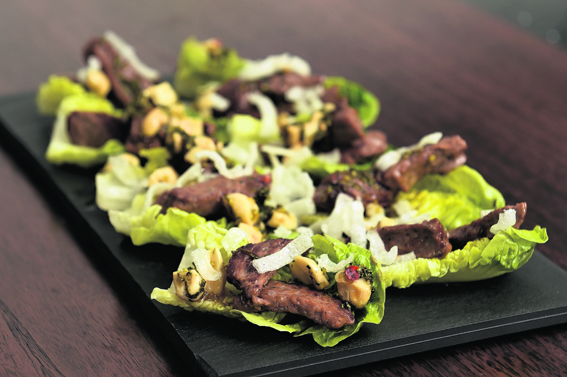 40g instant rice noodles (we used MAMA brand)
40g instant rice noodles (we used MAMA brand)
2 litres veg oil for deep frying
200g beef fillet
2 baby gem lettuce
50g cashew nuts
100g caster sugar
100ml rice wine vinegar
2tsp chilli flakes
50ml Thai fish sauce (nam pla)
15g fresh coriander
3cm fresh ginger root
80ml coconut milk
Sea salt
Freshly ground pepper
First make the crispy noodles. Heat the veg oil in a deep fat fryer or wok to 180C. Check the temperature of the oil – if you don’t have a thermometer, drop in a single noodle and it should puff up in 2-3 seconds without burning. Add the noodles to the oil; they will expand very quickly and dramatically. Lift them out using a strainer and transfer to a baking sheet lined with paper towel to dry.
Next, slice the beef fillet into thin strips and rub with a dusting of salt, pepper and olive oil. Heat a frying pan to hot and seal the beef, avoiding fiddling with the meat – move it too soon and it’ll stick.
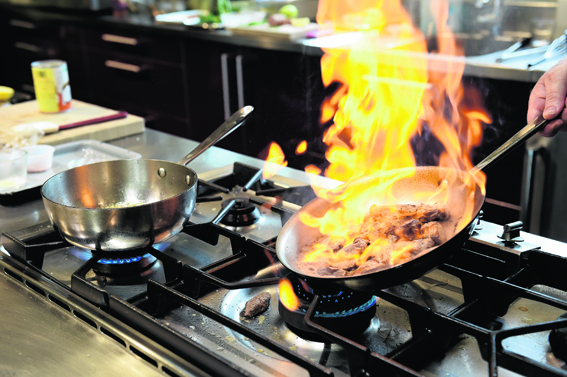 Once the beef is browned add the coconut milk, reduce the heat and cook for 4-5 minutes, stirring occasionally. The coconut milk will reduce down to give a sticky coating.
Once the beef is browned add the coconut milk, reduce the heat and cook for 4-5 minutes, stirring occasionally. The coconut milk will reduce down to give a sticky coating.
Grate the ginger, unpeeled, onto the middle of a sheet of muslin or a clean tea towel. Fold over the muslin or tea towel to create a makeshift piping bag and squeeze over a bowl to wring out the juice from the ginger by slowly twisting the cloth with the ginger inside. Keep the juice ready for the dipping sauce. Next, crush the nuts in a pestle and mortar, don’t process them too far as chunky bits are good for crunch.
Add the rice wine vinegar to a pan, followed by caster sugar, and stir. Add the Thai fish sauce, chilli flakes and ginger juice. Cook on a low heat for five minutes. Add the chopped nuts and heat for another minute. Finally throw in the chopped coriander. Take off the heat.
Peel off the leaves from the baby gems and lay out on the serving plate. Spoon a piece or two of beef into each baby gem leaf, and then drizzle the dipping sauce over. Finally scrunch up the cooled crisp fried noodles over the top.
MONKFISH WITH CURRIED LENTILS
SERVES 4
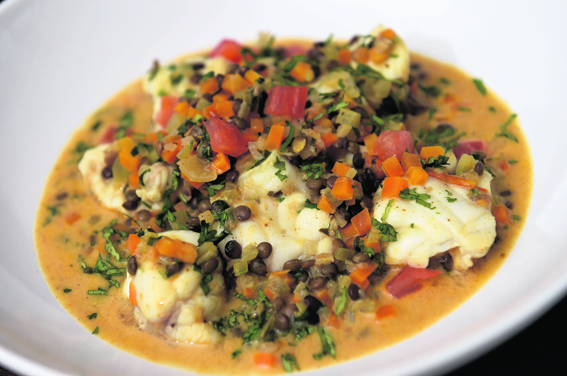 4 monkfish fillets, weighing about 100g each
4 monkfish fillets, weighing about 100g each
200g puy lentils
50ml olive oil
25g carrot, very finely diced
25g celery, very finely diced
25g leek, very finely diced
1 garlic clove, crushed and then finely diced
2cm piece of root ginger, finely diced
1tsp curry paste (paste not sauce; we like Patak’s Madras)
300ml chicken (or veg) stock
3 ripe vine tomatoes, roughly chopped
3tbsp chopped fresh coriander or chervil
2tbsp sunflower oil
Squeeze of lemon juice
2tbsp crème fraîche
Maldon salt
Freshly ground pepper
First cook the puy lentils in boiling water for 20-30 minutes or until tender. Drain them in a colander and spread on a tray to dry. Warm the olive oil in a saucepan and sweat the carrot, celery, leek, garlic and ginger until soft.
Add the curry paste and a little seasoning and cook for 2-3 minutes. Stir in the lentils, then add the stock and bring to the boil. Check the seasoning. Simmer for 30 seconds, or until you have a loose sauce. Not too wet, not too dry. Then remove from the heat.
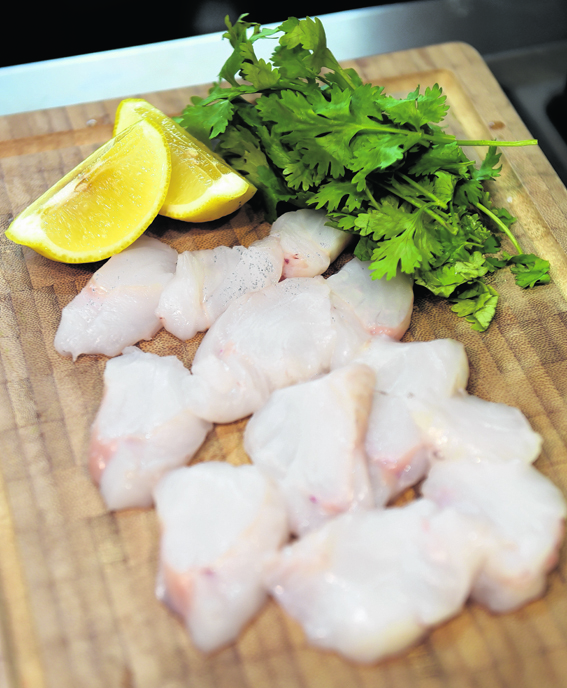 Stir the crème fraîche into the lentils. Now add the monkfish and keep hot for 2-3 minutes until just cooked. Add the chopped tomatoes and the chopped coriander or chervil.
Stir the crème fraîche into the lentils. Now add the monkfish and keep hot for 2-3 minutes until just cooked. Add the chopped tomatoes and the chopped coriander or chervil.
Serve immediately, dividing the lentils between four warmed serving bowls, making sure the sauce and fish is evenly distributed.
